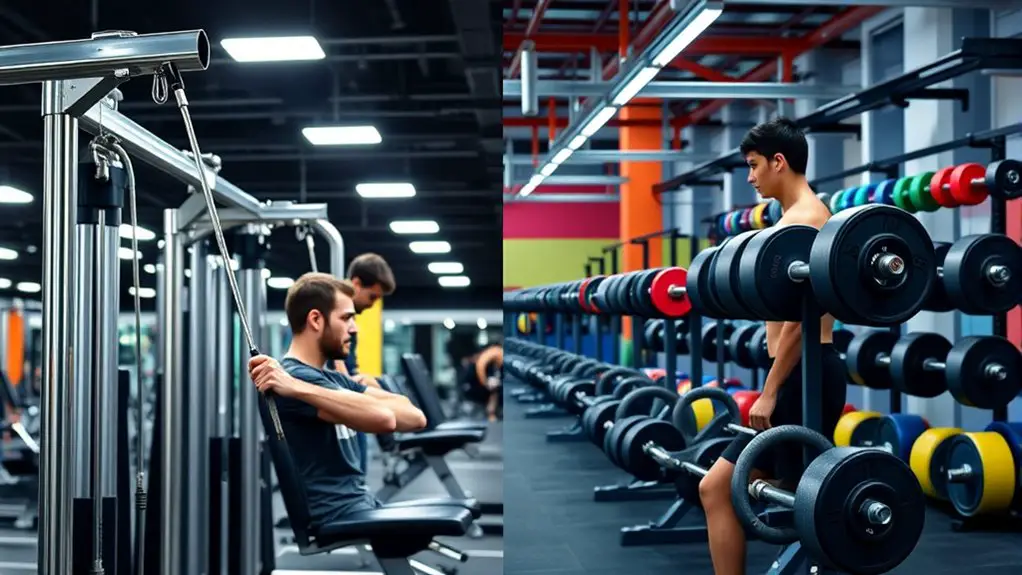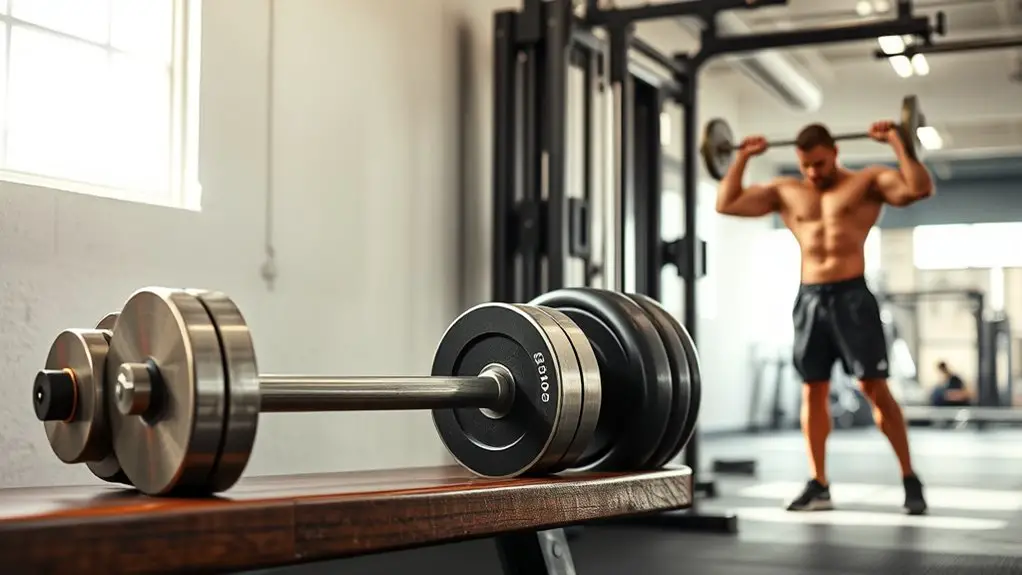Cable Machines vs. Free Weights: Pros & Cons

When comparing cable machines and free weights, you’ll find both have their pros and cons. Cable machines offer versatility, safety for beginners, and maintain proper form, but can limit natural movement and require equipment access. On the other hand, free weights improve functional strength and engage stabilizing muscles, though they pose a higher injury risk and necessitate good technique. So, which option really fits your fitness goals? Discover more about what each can offer you.
Advantages of Cable Machines

One major advantage of cable machines is their versatility. With adjustable pulleys and attachments, you can perform a wide range of exercises targeting different muscle groups. This cable versatility allows you to tailor your workouts to meet your specific fitness goals, whether you’re looking to build strength, improve stability, or enhance flexibility.
Moreover, using cable machines can be safer than free weights, especially for beginners. The guided movement helps maintain proper form, reducing the risk of injury. Since the cables provide constant tension, you can control your range of motion, which is essential for injury prevention. You’ll feel more secure as you experiment with various exercises, knowing that the machine supports your movements.
Ultimately, cable machines offer a safe, adaptable option for anyone serious about their fitness journey. You can confidently explore new exercises while minimizing the risk of injuries, making cable machines an excellent addition to your routine.
Disadvantages of Cable Machines
While cable machines offer a variety of benefits, they also come with some disadvantages that can affect your workout experience. One key drawback is the limited range of motion they provide. This can restrict your muscle activation and may not mimic real-life movements effectively. Additionally, reliance on cable machines can create dependency issues; if you solely rely on them, you might struggle when shifting to free weights or different training styles.
Here’s a quick overview of the disadvantages:
| Disadvantage | Description | Safety Concern |
|---|---|---|
| Limited Range | Restricts natural movement patterns | May lead to injury |
| Dependency Issues | Over-reliance can hinder overall strength | Reduced functional fitness |
| Equipment Availability | Not always available in busy gyms | Can interrupt workout |
| Learning Curve | Requires understanding of settings and usage | Incorrect use can cause injury |
| Cost | Generally more expensive than free weights | Budget constraints |
Consider these factors before you make cable machines your go-to for every workout.
Benefits of Free Weights

Despite the limitations of cable machines, free weights offer a range of advantages that can enhance your workout experience. One key benefit is the increased muscle engagement you get when lifting free weights. Unlike machines, which guide your movements, free weights require you to stabilize your body, promoting greater strength across multiple muscle groups. This not only helps in building functional strength but also improves your coordination and balance, which are essential for everyday activities.
Additionally, free weights allow for a more natural range of motion, reducing the risk of injury. You can easily adjust your grip and body position, tailoring the exercise to your comfort and safety needs. Plus, using free weights can keep your workouts varied and interesting, helping you stay motivated. By incorporating free weights into your routine, you’ll develop a strong foundation that can benefit your overall fitness journey.
Drawbacks of Free Weights
Although free weights have numerous advantages, they also come with some drawbacks that can impact your workout experience. One major concern is injury risk. Because free weights require more stabilization than machines, improper form can lead to strains or sprains. If you’re not careful, you could easily hurt yourself, especially when lifting heavier weights.
Another issue is the potential for strength imbalances. When using free weights, it’s easy to favor one side of your body over the other, which can create disproportionate strength levels. This imbalance not only affects your overall strength but may also increase your injury risk in the long run.
To minimize these drawbacks, it’s essential to focus on proper technique and consider working with a trainer, especially if you’re new to weightlifting. Keeping safety in mind will help you enjoy the benefits of free weights while reducing the chances of injury.
Choosing the Right Option for Your Goals

When you’re deciding between cable machines and free weights, it’s crucial to align your choice with your fitness goals. If your goal specificity leans toward muscle isolation and controlled movements, cable machines might be your best bet. They offer stability, which can be especially beneficial if you’re new to strength training or recovering from an injury.
On the other hand, if you have more training experience and aim for overall strength and functional fitness, free weights can provide a more thorough workout. They engage stabilizing muscles and mimic real-life movements, enhancing your balance and coordination.
Ultimately, consider your comfort level and safety. If you’re uncertain about your form or need extra support, start with cable machines. As you gain confidence and expertise, you can gradually incorporate free weights into your routine. Choose what’s right for you, and you’ll set yourself up for success.
Frequently Asked Questions
Can Cable Machines Help Improve My Balance and Stability?
Like a tightrope walker mastering their craft, you can use cable machines to enhance your balance and stability. These machines provide controlled resistance, allowing you to focus on balance training without the fear of losing control. The stability benefits from cable exercises can translate into better overall coordination and strength. When you engage in this kind of training, you’re building a solid foundation, ensuring your safety as you progress in your fitness journey.
Are Free Weights Safer for Beginners Compared to Cable Machines?
When you’re starting out, free weights can be safer than cable machines, especially if you focus on proper form. They allow for natural movement patterns, which can help you build weightlifting confidence. However, without guidance, beginners might risk injuries due to instability or improper technique. Always consider starting with lighter weights and seeking advice from a trainer to guarantee you’re lifting safely and effectively as you build your strength.
How Do Cable Machines Affect Muscle Activation Differently Than Free Weights?
Using cable machines is like charting a well-marked path, while free weights can feel like a winding trail. When you use cable machines, you often experience consistent muscle engagement due to their controlled resistance variation. This can help you focus on specific muscle groups safely, reducing the risk of injury. In contrast, free weights engage stabilizer muscles more, but they require a bit more caution to maintain proper form and avoid accidents.
Can I Perform Compound Exercises on Cable Machines?
Yes, you can perform compound exercises on cable machines! Their cable versatility allows you to engage multiple muscle groups effectively. With proper exercise selection, you can target your chest, back, legs, and more while maintaining control and stability. This can enhance safety during your workouts, reducing the risk of injury. Just make sure you’re using the right attachments and adjusting the weight to match your strength level for the best results.
What Is the Cost Difference Between Cable Machines and Free Weights?
Think of your fitness journey as a treasure hunt; you need to weigh your equipment investment carefully. When it comes to cost comparison, cable machines typically hit your wallet harder than free weights. While a solid cable machine can be pricey, free weights offer a budget-friendly option for safety-conscious lifters. Ultimately, your choice should reflect your budget and training goals, ensuring you find the right balance between quality and cost.





